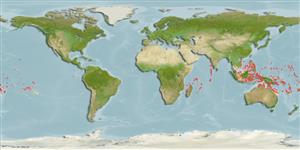分类 / Names
俗名 | 同种异名 | Catalog of Fishes(属, 种) | ITIS | CoL | WoRMS | Cloffa
Teleostei >
Anguilliformes (Eels and morays)
鰻目 (Eels and morays) >
Muraenidae (Moray eels)
鯙科 (Moray eels) > Muraeninae
Etymology: Echidna: Greek, echidna = viper, 1847 (Ref. 45335).
Eponymy: In Greek mythology Echidna was a female monster, and mother of many other monsters including the Hydra. Hesiod described her as “half a nymph with glancing eyes and fair cheeks, and half again a huge snake, great and awful, with speckled skin.” (Ref. 128868), visit book page.
More on author: Schultz.
Environment: milieu / climate zone / depth range / distribution range
生态学
海洋; 淡水; 半咸淡水 礁区鱼类; 深度上下限 0 - 24 m (Ref. 9710). 热带; 17°N - 24°S
Indo-Pacific: East Africa to the Line and Tuamoto islands, north to Johnston Island.
印度-太平洋: 东非到列岛群岛与 Tuamoto 岛, 北至詹斯顿岛。
大小 / 重量 / 年龄
Maturity: Lm ? range ? - ? cm
Max length : 75.0 cm TL 雄鱼/尚未辨别雌雄; (Ref. 1602)
背棘 (总数) : 0; 背的软条 (总数) : 0; 臀棘: 0; 臀鳍软条: 0; 脊椎骨: 121 - 130. Plain brown in color, snout with white tip, jaw with irregular white patches; darker behind eye and corner of mouth (Ref. 3257). Stout conical teeth that tend to become pebble-like, more numerous, and closely-packed with age.
一致褐色的颜色, 吻部有白色的顶端, 颌有不规则的白色区块; 较深色的在后眼与嘴角.(参考文献 3257) 矮胖的锥形齿逐渐变成卵石状的,众多的,与紧密的随着年龄。
Occurs among rubble deposits on the lee side of shallow wave-washed reefs. Feeds on crustaceans (Ref. 9710, 58302; 89972). Benthic (Ref. 58302).
在水浅波浪冲刷的礁的背风面上的碎石堆积层之中生存。 吃甲壳动物。 (参考文献 9710)
Life cycle and mating behavior
成熟度 | 繁殖 | 产卵场 | 卵 | 孕卵数 | 仔鱼
印度-太平洋: 东非到列岛群岛与 Tuamoto 岛, 北至詹斯顿岛。
Myers, R.F., 1991. Micronesian reef fishes. Second Ed. Coral Graphics, Barrigada, Guam. 298 p. (Ref. 1602)
世界自然保护联盟红皮书 (Ref. 130435: Version 2024-1)
人类利用
工具
特别资料
下载 XML
网络资源
Estimates based on models
Preferred temperature (Ref.
123201): 25.8 - 29.3, mean 28.4 °C (based on 1822 cells).
Phylogenetic diversity index (Ref.
82804): PD
50 = 0.5005 [Uniqueness, from 0.5 = low to 2.0 = high].
Bayesian length-weight: a=0.00049 (0.00024 - 0.00099), b=3.26 (3.10 - 3.42), in cm total length, based on LWR estimates for this (Sub)family-body shape (Ref.
93245).
营养阶层 (Ref.
69278): 3.5 ±0.60 se; based on food items.
回复力 (Ref.
120179): 中等的, 族群倍增时间最少 1.4 - 4.4年 (Preliminary K or Fecundity.).
Fishing Vulnerability (Ref.
59153): Moderate to high vulnerability (50 of 100).
Nutrients (Ref.
124155): Calcium = 34.5 [19.1, 61.8] mg/100g; Iron = 0.462 [0.276, 0.837] mg/100g; Protein = 18.9 [16.6, 21.4] %; Omega3 = 0.104 [0.047, 0.282] g/100g; Selenium = 35.4 [19.4, 68.0] μg/100g; VitaminA = 60.3 [17.3, 199.7] μg/100g; Zinc = 1.25 [0.89, 1.73] mg/100g (wet weight);
